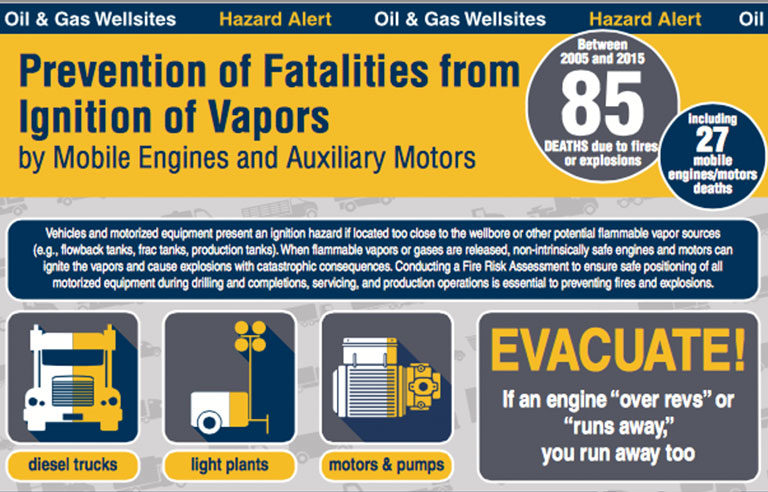Hazard alert, training module address engine-vapor dangers in oil and gas

Washington – In an effort to prevent fatalities stemming from the ignition of vapors by vehicles and motorized equipment in the oil and gas industry, OSHA; NIOSH; and the National Service, Transmission, Exploration & Production Safety Network have partnered on a hazard alert.
Vehicles and motorized equipment can become hazardous if they are too close to a wellbore or other flammable source, such as flowback tanks, frac tanks or production tanks. The hazard alert recommends using a Fire Risk Assessment to ensure motorized equipment is positioned safely during work. It also suggests reviewing the following points with employees:
- When an engine “over revs” or “runs away,” it is in a gas/vapor cloud and the area should be evacuated. All employees should know emergency procedures and specific duties in shutdown operations.
- Identify possible sources for release of flammable gases/vapors and evaluate their locations in relation to other ignition sources on the site. Take into account changing winds, temperature and other weather variables.
- Establish entry routes, acceptable areas and boundaries for vehicles and motorized equipment. Make sure they stay in those zones.
- Create a Job Hazard Analysis that includes fire hazards. Review the JHA, fire prevention procedures and emergency evacuation protocol on a daily basis during each shift.
The hazard alert contains other preventive measures and engineering controls:
- Monitor for flammable gases/vapors and oxygen.
- Install shutdown systems or other protective measures for mobile engines.
- Turn off running/idling vehicles or equipment that are not essential.
- Use administrative control methods, such as a safe work permit system, to manage access of vehicles or motorized equipment into areas that might have flammable gas/vapors.
- Train workers on ignition hazards of internal combustion engines.
- Remove from hazard zones any potential ignition sources – such as cigarettes, open flames or tools – that can cause sparks.
- Mandate that workers wear personal protective equipment and pay attention to all alarms.
In related news, OSHA has added a training module on transportation in its Oil and Gas Well Drilling and Servicing eTool. The module covers transporting personnel and equipment, vehicle operations at the well site, and all-terrain vehicles and utility task vehicles, along with other resources.
OSHA states that highway vehicle incidents are the leading cause of worker fatalities in the oil and gas industry, responsible for about 40 percent of on-the-job deaths.
Post a comment to this article
Safety+Health welcomes comments that promote respectful dialogue. Please stay on topic. Comments that contain personal attacks, profanity or abusive language – or those aggressively promoting products or services – will be removed. We reserve the right to determine which comments violate our comment policy. (Anonymous comments are welcome; merely skip the “name” field in the comment box. An email address is required but will not be included with your comment.)

